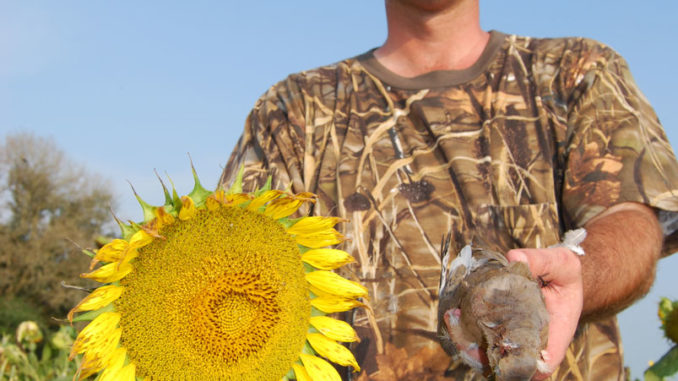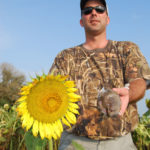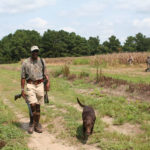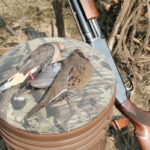
Be ready when opening day arrives, whether you’re hunting on private land or on a field planted by your state wildlife agency, and you’ll knock down more than just feathers.
A lot of hunters enjoy beautifully prepared and managed dove fields because they know landowners who enjoy the sights, sounds and smells of a well-spent Labor Day weekend dove shoot. And a lot have just as much enjoyment hunting on public fields provided by the N.C. Wildlife Resources Commission and S.C. Department of Natural Resources, experiencing the kind of shooting normally reserved for those with access to private land.
If you don’t have access to dove hunting on private land, finding a public dove field in the Carolinas isn’t difficult. Start by visiting the hunting pages of the agencies’ websites, www.dnr.sc.gov and www.ncwildlife.org and search for information on public dove fields and hunts. Identify the public fields in your general area and begin searching for specifics. Pick a couple close to home and start doing research. An on-site visit just before the season opens is a great way to see how the agencies have planted and manipulate grain crops to attract doves, as well as getting an idea of how birds use the fields: where they enter, light and leave. Are there any landmarks they fly over on their way in? Is there a certain part of the field where more birds drop in? After the Labor Day weekend rush, a phone call to an SCDNR or Commission office will often get you an assessment of current conditions.
Season dates and times differ between North Carolina and South Carolina, which changes the strategies of hunters heading to dove fields.
North Carolina’s dove seasons are Sept. 3-Oct. 8 and Nov. 21-Jan. 14, with a 15-bird bag limit and hunting from 30 minutes before sunrise until sunset. South Carolina’s dove seasons are Sept. 3-Oct. 15, Nov. 12-26 and Dec. 15-Jan. 15, with a 12-bird bag limit. Hunting is 30 minutes before sunrise until sunset, except for the first three days of the season, when hunting cannot begin until noon.
Early season hunts are almost always hot affairs, even those in North Carolina that begin before first light. Be prepared with plenty of water and a light rain poncho, especially for afternoon hunts with passing showers or thunder storms are common. On hunts with a noon kickoff, find a shady spot under some trees around the edge of the field. Setting up in the middle of a sun-baked field can drain your enthusiasm quickly. When the action picks up, you can pick out a prime location in the field. Often, you can “reserve” a prime spot by putting a chair or bucket down while you want for the action to heat up.
If you really don’t like the heat, show up a little later. Some hunters will quit early because of the heat, other commitments or because they’ve reached their limit. Lots of good spots are often vacant by 5 p.m. Show up around 3 p.m. and hang around until shooting time ends; it can be a very productive time.
Hitting those dipping, diving birds can be a problem for many hunters, and it’s actually much harder hitting them in a field with dozens of other hunters. One trick that can increase your odds of limiting out is to shoot at birds earlier. Don’t wait until the birds are on top of you to shoot. At 40 or 50 yards — as opposed to 20 yards — your shot pattern is larger and just as lethal on doves, which are often brought down by a single pellet. Shoot before they see you and dive out of the way. Nothing justifies sky-busting birds at ridiculous ranges.
When it comes to shotguns and shot size, there are many options. Autoloaders will burn up a lot more ammunition and probably not bring home any more birds than double barrels. Wardens will check that autoloaders and pumps are plugged to hold only three shells. Generally, more 12-gauge guns are in the field, probably because that’s what people own, but 20- or even 28-gauge shotguns throw just as big a pattern, though not as dense. Most shooters use No. 7 1/2 or 8 shot, a modified choke is probably a good compromise.
Some shooters haul decoys to dove fields, and they probably help attract attention, especially the whirling wing type. Many dove fields are large, especially those managed for public hunts, and birds are using them because food is plentiful. Anything that channels them toward you is good.
If you are fortunate to own a good dog, be careful. The heat and excitement of an early season dove shoot can result in heat stroke and even death. If you can, buy a bag of ice, cover it with a piece of burlap, and let the dog rest on it between retrieves to help keep him or her cool Also, have plenty of water for the dog.
As far as luck is concerned, sometimes you do everything right by being well hidden in a good place where the birds are flying toward you, only to have a crack shot in front of you who knocks every one of your birds before they get to you. It happens. Just hope he limits out early so you can have some fun.






Be the first to comment